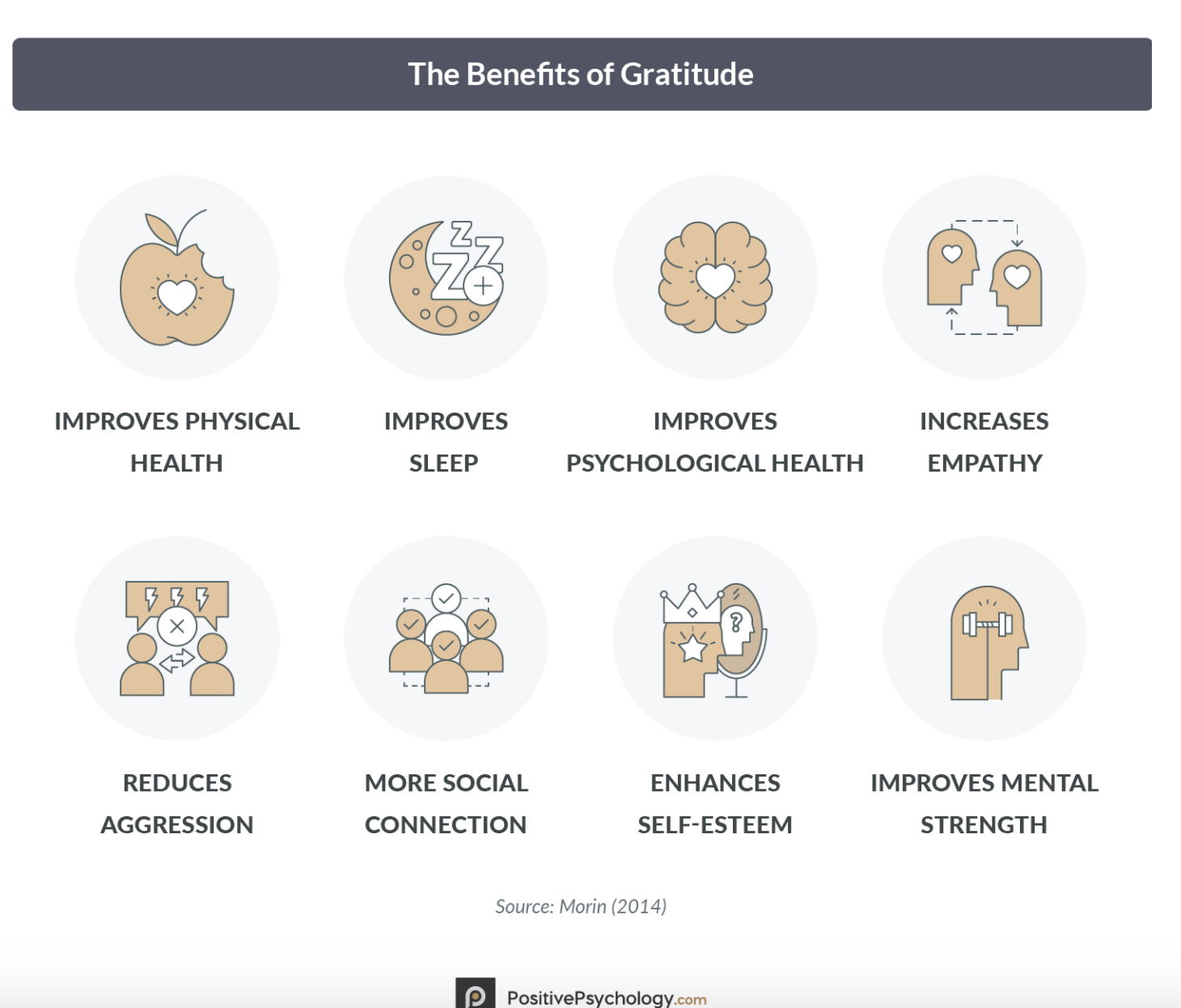For most people, 2020 has not been a year that sparks positivity. The past twenty years of my life at Thanksgiving, each family member shares a few things we are thankful for. This year, my family isn’t getting together for Thanksgiving. I’m sure many aren’t. But if we were together, we may all need extra brainstorming time to genuinely come up with a “gratitude list.”
The good news is positive psychology research finds that gratitude helps us cope with crisis. We benefit when we realize we have the power and control to change our thinking and turn challenges into opportunities. We have the ability to reflect on what we are grateful for in a difficult situation – and our reflection can reframe a negative into a positive. We should still realize and feel our painful feelings like grief, sadness, and loss; but we do well to take the time to focus on the good also.
Benefits of Gratitude:
Gratitude not only improves our mental health. According to research, gratitude increases our ability to empathize with others, helps our sleep (2020, we want our good sleep back!), builds up our self-esteem, and improves our physical health. 
Gratitude in the Classroom:
Teachers can focus on helping students increase feelings of gratitude during this Thanksgiving season:
-
Thank You Cards (or Emails):
Have students reflect on someone they appreciate within the school and write them a thank you note (or email during virtual learning). During the school day, give them time to write and deliver the cards. Afterwards, have a class reflection on how the activity made them (and the recipient) feel. Check out this resource for more information on thank you card writing.
-
Gratitude Calendar Conversations:
Teachers can print a blank calendar for the month of November (or any month of the school year!) For each day of the month, a teacher can choose a question for students to reflect on and discuss together. The conversation can be centered around questions like these! Check out this resource to learn more about the gratitude calendar.
-
Gratitude Quilt:
In the classroom, you can make a visual gratitude reminder using paper and tape (or other creative materials of your choice). Have each student write down something they are grateful for on a square and put them all together to create a wall “quilt” or some other kind of visual space in your classroom. Here is more information on the gratitude quilt. If you are in a virtual learning environment, the quilt can still be done. Each student can send a picture of something they wrote on a piece of colored paper at home and the teacher can put them all together in a word doc, PowerPoint, or other virtual visual.
Gratitude Activities for You:
These activities don’t take long, and can have big impacts on your own feelings of gratitude during this difficult time. Try these activities for yourself this week:
-
Gratitude Conversation Prompts:
Compile a list of conversation prompts and choose a different one each day. These conversations could be done individually as a reflection each day or you can bring them to your breakfast, lunch, or dinner table roommates or family members. Here are a few conversation prompts:
-
- I’m grateful for these three people in my life…
- I’m grateful for these three teachers (either past or present)…
- I’m grateful for this experience in my life…
- I’m grateful for the things I’ve learned this year like…
2. Daily Reflection Questions:
Each morning when you wake up or another time of the day that works best for you, reflect on the same few positivity-focused questions. These questions should be about what you’re grateful for and intentionally name positive things going on in your life. Check out this blog that shares questions you can ask yourself every day of quarantine.
3. Gratitude Journal:
Similar to a bullet journal, you could write down one thing that you’re grateful for before bed or some time throughout the day. Doing this can actually increase feelings of joy, decrease symptoms of sickness, and improve sleep (Marsh, 2011).
4. Gratitude Walk:
Walking is definitely one of my personal favorite activities. I feel less stressed, more mentally clear, and positive throughout the day when I get to take my morning stroll. To make the walk even more fruitful, intentionally think of and look for things you’re grateful for. It could be things in nature or reflecting on things you were grateful for yesterday or last week.
5. Gratitude Notes (or Emails):
Share your gratitude with others to spark joy for you and the recipient. Don’t feel like this needs to be a novel that you’re writing to someone. A few sentences about how they’ve made a positive impact on you and just letting them know that you are grateful for them is more than enough. Don’t worry about being perfect, just share your genuine thoughts and you both will quickly feel the positive emotions.
Check out even more gratitude exercises here!
Reach out to amanda@possip.com with more ideas on gratitude!


